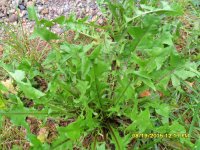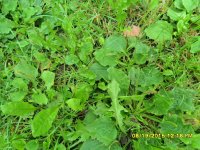You are using an out of date browser. It may not display this or other websites correctly.
You should upgrade or use an alternative browser.
You should upgrade or use an alternative browser.
ID this weed
- Thread starter jack707
- Start date
- Views: 2115
/ ID this weed
#1
95XL883
Gold Member
It might be a type of chicory but either round up or 2 4d should kill it. Maybe your herbicides are old or in too weak of dilution?
95XL883
Gold Member
Are you using a surfuctant? if the leaves are waxy, herbicide without surfuctant will just run off and not be absorbed by the plant. Liquid dish soap is supposed to work but I haven't tried it; I just use one that I bought at a nursery.
jack707
Veteran Member
Maybe I should use it straight! maybe the water is dilution it to much that it doesn't work. As far as being old I bought them this summer.
95XL883
Gold Member
Since you bought it this summer, the chemicals are most likely good. Did you buy Round Up and then dilute it? It has been years since I bought Round Up but I thought it was already diluted. You might check the directions but you probably need to add a surfuctant/dish soap.
I now buy glyphosate concentrate and cut it to slightly over 2%. (The instructions say 2% should kill most any grass or weed in the fileld.) For the concentrate I bought, I mix 7 ounces to 2.5 gallons of water and it has killed whatever I sprayed as long as I add a surfuctant.
I now buy glyphosate concentrate and cut it to slightly over 2%. (The instructions say 2% should kill most any grass or weed in the fileld.) For the concentrate I bought, I mix 7 ounces to 2.5 gallons of water and it has killed whatever I sprayed as long as I add a surfuctant.
Dr_Zinj
Veteran Member
Dude. First picture is a fine growing example of a dandelion!
Second picture has more dandelions, plus a couple of Common Plantains, not to mention the grass blades.
Personally, I like dandelions in the yard. The flowers are pretty. It's fun to blow the seed heads in the air. You can make dandelion wine from the flowers. You can pick the new leaves for salads, or cook them for a vegetable. You can dig up the roots, dry, roast, and grind them into a coffee substitute. There's even a company in Europe that has bred a variety of dandelion to produce a latex usable in automotive tires as a substitute for rubber.
Or you can just get a small hand digger and remove them that way. I did that a couple of times when I was in military housing and never had much trouble preventing them from coming back.
Wikipedia has it that Plantago major (broadleaf plantain, common plantain or greater plantain) is a species of plantago, family Plantaginaceae. The plant is native to most of Europe and northern and central Asia, but has widely naturalised elsewhere in the world.
Plantago major is one of the most abundant and widely distributed medicinal crops in the world. A poultice of the leaves can be applied to wounds, stings, and sores in order to facilitate healing and prevent infection. The active chemical constituents are aucubin (an anti-microbial agent), allantoin (which stimulates cellular growth and tissue regeneration), and mucilage (which reduces pain and discomfort). Plantain has astringent properties, and a tea made from the leaves can be ingested to treat diarrhea and soothe raw internal membranes.
Broadleaf plantain is also a highly nutritious wild edible, that is high in calcium and vitamins A, C, and K. The young, tender leaves can be eaten raw, and the older, stringier leaves can be boiled in stews and eaten.
Second picture has more dandelions, plus a couple of Common Plantains, not to mention the grass blades.
Personally, I like dandelions in the yard. The flowers are pretty. It's fun to blow the seed heads in the air. You can make dandelion wine from the flowers. You can pick the new leaves for salads, or cook them for a vegetable. You can dig up the roots, dry, roast, and grind them into a coffee substitute. There's even a company in Europe that has bred a variety of dandelion to produce a latex usable in automotive tires as a substitute for rubber.
Or you can just get a small hand digger and remove them that way. I did that a couple of times when I was in military housing and never had much trouble preventing them from coming back.
Wikipedia has it that Plantago major (broadleaf plantain, common plantain or greater plantain) is a species of plantago, family Plantaginaceae. The plant is native to most of Europe and northern and central Asia, but has widely naturalised elsewhere in the world.
Plantago major is one of the most abundant and widely distributed medicinal crops in the world. A poultice of the leaves can be applied to wounds, stings, and sores in order to facilitate healing and prevent infection. The active chemical constituents are aucubin (an anti-microbial agent), allantoin (which stimulates cellular growth and tissue regeneration), and mucilage (which reduces pain and discomfort). Plantain has astringent properties, and a tea made from the leaves can be ingested to treat diarrhea and soothe raw internal membranes.
Broadleaf plantain is also a highly nutritious wild edible, that is high in calcium and vitamins A, C, and K. The young, tender leaves can be eaten raw, and the older, stringier leaves can be boiled in stews and eaten.
jack707
Veteran Member
Since you bought it this summer, the chemicals are most likely good. Did you buy Round Up and then dilute it? It has been years since I bought Round Up but I thought it was already diluted. You might check the directions but you probably need to add a surfuctant/dish soap.
I now buy glyphosate concentrate and cut it to slightly over 2%. (The instructions say 2% should kill most any grass or weed in the fileld.) For the concentrate I bought, I mix 7 ounces to 2.5 gallons of water and it has killed whatever I sprayed as long as I add a surfuctant.
I don't add water to round up I was looking for a weed killer that had glyphosate but no one had any so I have to buy it thru mail order I can get 41% glyphosate.
RalphVa
Super Member
- Joined
- Dec 19, 2003
- Messages
- 7,885
- Location
- Charlottesville, VA, USA
- Tractor
- JD 2025R, previously Gravely 5650 & JD 4010 & JD 1025R
I agree with Dr_Zinj. Both are edible. You can make a very nice plantain tonic by putting a few leaves with pineapple juice or chunks into a blender. Maybe add a little bit of yogurt. Keep in frig.
I wouldn't kill them. Enjoy them.
Ralph
I wouldn't kill them. Enjoy them.
Ralph
jack707
Veteran Member
Not for me I'll pass.


